Newcastle Corporation Follow-Up
Newcastle Corporation Follow-Up
A follow-up to the recent thread posted by Ronnie Hoye of a line up of Newcastle Corporation buses lined up for a race meeting at Gosforth Park Racecourse. Ian T put in a query about Newcastle's CVG6s with Birmingham style bodies and what appears below is an answer to that.
In 1948 Newcastle Corporation received two batches of vehicles, one of trolleybuses the other motor buses, both to the design of other operators right down to details such as destination layout and window opening arrangements. The incentive was quick delivery and in both cases the bodywork was by Metro-Cammell.
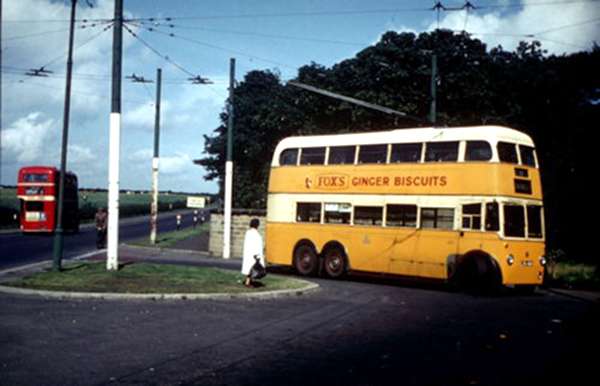
The trolleybuses were 479-98 (LTN 479-98), BUT 9641Ts with H40/30R bodies. These quickly became famous as the 'Gosforth' trolleys, retaining the partially blacked-out LT-style destination apertures and wind-down windows throughout their lives with Newcastle. A picture of one at Gosforth Park terminus is attached.
The motor buses were 59-72 (KVK 959-72,) Daimler CVG6s with H31/24R bodies to the standard Birmingham
Corporation design, including straight staircases and drop-windows. The standard 3-aperture Newcastle
destination layout was fitted very quickly to these vehicles at the front, but a side destination box above
the rear entrance was never fitted. Newcastle had procured a batch of 25 CVG6 chassis from Daimler, the
others (73-83 KVK 973-83) being bodied by C H Roe in 1947, so coincidentally all 25 received bodies with
straight staircases.
The attached photos show:
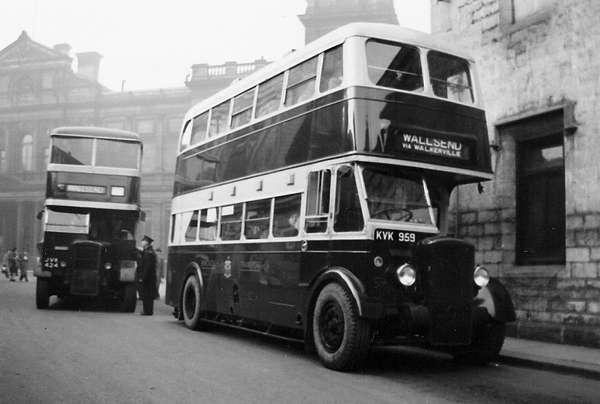
59 as delivered in Newcastle's short-lived simplified post-war dark blue and cream livery with grey roof. Behind is another Daimler, no. 4 (JVK 424), but this time it's a CWA6 from 1946, temporarily carrying the Park Royal body from 144 (VK 4088), a 1931 Daimler CH6, also in the post-war blue livery. No. 4 and the rest of the 1-5 batch initially received bodies from withdrawn pre-war buses then new bodies by Mann Egerton (H30/26R) in 1950.
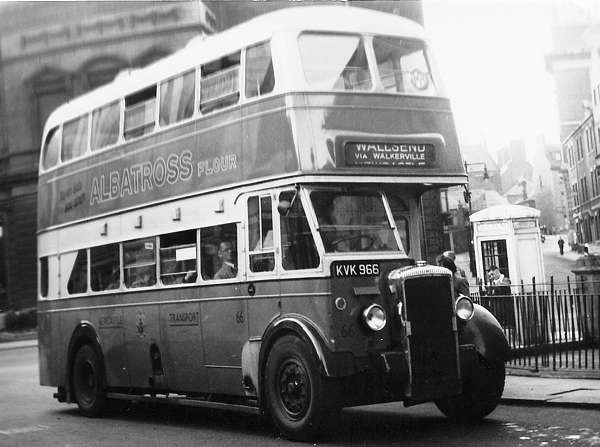
66 is shown following repaint into Newcastle's new standard yellow bus livery, adopted in 1949 and exactly matching the post-war trolleybus livery. Its Birmingham indicator is retained.
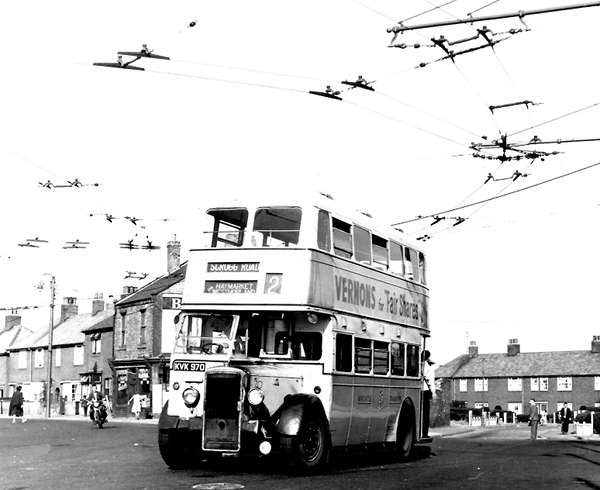
70 is my favourite shot of one of these buses, on service 2 at its terminus in Walker, showing a nice bit of trolleybus overhead. An interesting location, this, at the point where Church Street joins Walker Road, as four trolleybus and motorbus services turned here but used different destination names - Walker, Church Street or Scrogg Road. The nearby shipyard and engineering works required large numbers of buses to be in the vicinity at shift change-over times so this junction was often extremely busy.

Finally, no. 67 while in subsequent service with Hull Corporation as no. 126. Nine of the 59-72 batch (60/1/3/4/6/7/9-71) were sold in 1961 to Hull together with no. 80 (KVK 980), one of the CVG6s with Roe bodywork, for trolleybus replacement. They were numbered 121-30 by Hull and soldiered on until 1966/7.
Anthony Fox
01/2015
06/01/15 - 06:30
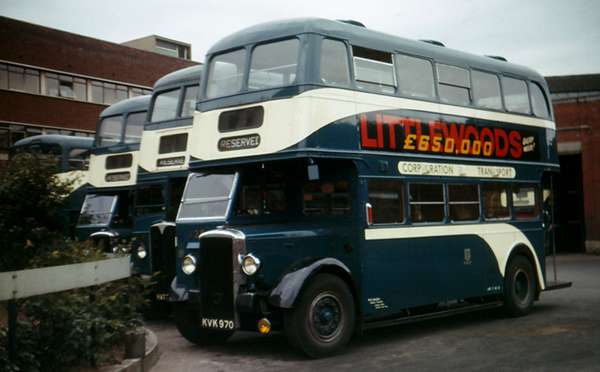
Here is a colour shot of 70 which was posted quite a while ago at this link.
Peter
08/01/15 - 14:25
Thanks, Richard S and Anthony Fox (wonderful pictures!), for the clarification on Newcastle's "Birmingham" Daimlers. I wonder why this body wasn't more widely adopted, even on other chassis. Cost? Loss of a couple of seats?
Ian T
04/02/16 - 17:00
There are some wonderful immediate postwar scenes of Newcastle, including the blue
Daimlers and many more buses, trams and trolleybuses, on the following clip:
https://www.youtube.com/watch?v=UlPOIjfFdw0
This has been taken from the Online Videos production of Newcastle Trolleybuses.
Out of interest does anybody know if Newcastle purchased any motorbuses during the war years, apart from the
4 Guy Arabs and 2 Daimler CWAs listed elsewhere on this site? If not, I assume that partly explains why
there was such an urgent need for new vehicles afterwards. Also, were any of the 6 utilities listed of
normal high bridge layout?
Mike Morton
05/02/16 - 15:12
In the early months of WWII Newcastle Corporation received 227-39, HTN 227-39,
final 13 of a batch of 18 Daimler COG5s bodied locally by Northern Coachbuilders. Two other COG5s, 240/1,
but bodied by NORTHERN COUNTIES, also arrived at that time. If anyone knows how/why NCME got the business
for bodying the last two of this batch of twenty COG5s, please post! It�s a mystery�
The only other motor buses delivered during the war were five highbridge H30/26R vehicles in 1942 (242-4,
JTN 242-4, AEC Regent I, Park Royal bodywork and 245/6, JTN 505/6, Guy Arab I, Massey bodies) and four
lowbridge L27/28R in 1943 (247/8, JTN 607/8, Guy Arab I, Strachans bodies and 249/50, JTN 619/20, Daimler
CWG5 (not CWA6), Brush bodies). All were to utility �standard� of course. Here�s a line-up pic of Arabs
245/8/6/7, nicely showing their relative heights.

Five new Daimler CWA6 chassis were acquired just after the war and given temporary
second-hand bodies from pre-war vehicles (numbered 1-5, JVK 421-5). They all received new bodies at Mann
Egerton in 1950 (another mystery tale there!).
Two of the AECs, 242/3, ran on for many years post-war as driver training vehicles, cut down to single-deck
and renumbered 917/8 in the Miscellaneous fleet. This picture of 918 has appeared elsewhere in these pages.

AEC 244 and the Guys were all withdrawn in 1950, 247 passing to Darlington Corporation also as a DTV. 249/50 soldiered on until 1956 (receiving standard Newcastle three-aperture destination indicators and the new yellow livery in the process) when they and the dozen or so then remaining pre-war vehicles in the fleet were taken out of service.
Anthony Fox
08/02/16 - 16:33
Thanks for the useful information Anthony. I suspected the overlapping pre-war orders had just about kept the motor bus division of Newcastle Corporation going. That has to be one of the most evocative photos of wartime utilities I have seen - every shade of grey (unless its the light and all those angles) rather than 'sanitized' in postwar livery and lining. I imagine by the end of hostilities even these would have been repainted in the blue livery.
Mike Morton
Comments regarding the above are more than welcome please get in touch via the 'Contact Page' or by email at
If you have any bus related photographs that you would like to appear in a gallery on this website please send them to me by email at
All rights to the design and layout of this website are reserved Old Bus Photos does not set or use Cookies but Google Analytics will set four see this
Old Bus Photos from Saturday 25th April 2009 to Monday 8th August 2022